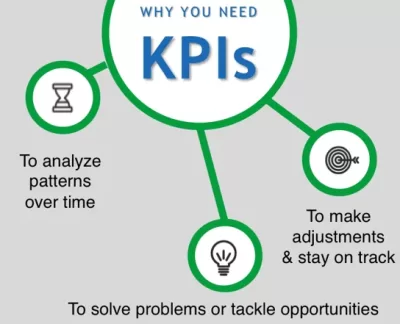Reasons For Measuring Marketing Performance Success
Why do you measure the success of your efforts? I think you do that because you have goals and want to determine if you have achieved them or track the journey. This is why measuring the success of your marketing efforts is necessary.
Measuring healthcare marketing success for your organization will help you see how effective your marketing efforts were and determine areas for improvement. That’s where KPIs come in. KPIs, or Key Performance Indicators, are specific metrics that help you evaluate your marketing efforts and determine what’s working and what’s not.

Determining which KPIs to use varies from industry to industry, so in healthcare marketing, there are several KPIs that are particularly important. These might include metrics related to patient acquisition, patient retention, and patient satisfaction. By tracking these KPIs over time, you can get a better sense of how your marketing campaigns are impacting your bottom line, and make adjustments as needed to optimize your results.
Of course, choosing the right KPIs is only half the battle. Once you’ve identified the metrics that matter most to your healthcare marketing efforts, you’ll need to develop a tracking and analysis plan. This might involve setting up a dashboard to monitor your KPIs in real time or working with a data analyst to build custom reports that provide deeper insights into your marketing performance. Whatever approach you choose, the key is to stay focused on the metrics that matter most to your healthcare marketing goals.
Essential KPIs for Healthcare Marketing
As a healthcare marketer, you need to track specific metrics to determine the effectiveness of your campaigns. Here are some essential KPIs that you should focus on:

Patient Acquisition Cost
Patient acquisition cost (PAC) is the money you spend to acquire a new patient. It includes all the costs associated with marketing, such as advertising, events, and promotions. To calculate PAC, divide the total marketing costs by the number of new patients acquired during that period. A high PAC may indicate that your marketing campaigns are not cost-effective.
Conversion Rate
Conversion rate is the percentage of website visitors who take a desired action, such as filling out a form or calling to make an appointment. A higher conversion rate means your website effectively engages visitors and encourages them to take action. You may need to optimize your website design, content, and calls-to-action to improve your conversion rate.
Patient Lifetime Value
Patient lifetime value (LTV) is the total amount of money a patient is expected to spend on your services over their lifetime. It considers factors such as the frequency of visits, the types of services received, and the patient’s age and health status. A high LTV indicates that your patients are loyal and satisfied with your services. To increase LTV, you may need to focus on patient retention and offer additional services to existing patients.
Appointment Show Rate
The appointment show rate is the percentage of patients who attend their scheduled appointments. A low show rate can result in lost revenue and wasted resources. You may need to send appointment reminders, offer flexible scheduling options, and provide incentives for patients who show up on time to improve your show rate.
Digital Marketing Performance KPIs
When measuring the success of your healthcare marketing efforts, digital marketing performance is a crucial aspect to consider. By tracking key performance indicators (KPIs) related to your digital marketing channels, you can gain valuable insights into how your campaigns are performing and identify areas for improvement.

Website Traffic
Website traffic is a critical KPI for healthcare marketers as it provides insights into the number of visitors visiting your website. By tracking website traffic, you can identify which pages are most popular and which are not receiving as much traffic. This information can help you optimize your website and improve your user experience.
To track website traffic, you can use tools like Google Analytics, which provides detailed insights into your website’s traffic sources, pageviews, bounce rates, and more. By regularly monitoring your website traffic, you can identify trends and make data-driven decisions to improve your website’s performance.
Social Media Engagement
Social media engagement is another important KPI for healthcare marketers. By tracking it, you can measure the effectiveness of your social media campaigns and identify which types of content resonate most with your audience.
You can use social media analytics tools like Hootsuite or Sprout Social to track social media engagement. These tools allow you to track metrics like likes, comments, shares, and followers, giving you a comprehensive view of your social media performance.
Email Campaign Effectiveness
Email campaigns are a powerful tool for healthcare marketers, that allows you to reach out to patients and prospects directly. To measure the effectiveness of your email campaigns, you can track metrics like open rates, click-through rates, and conversion rates.
Tools like Mailchimp or Constant Contact provide detailed analytics on your email campaigns, allowing you to see which emails are performing well and which need improvement. Regularly monitoring your email campaign metrics can optimize your campaigns for better results.
Search Engine Ranking
Search engine ranking is a critical KPI for healthcare marketers as it directly impacts your website’s visibility and traffic. By tracking your search engine ranking, you can identify which keywords are driving traffic to your website and which ones need improvement.
To track your search engine ranking, you can use tools like SEMrush or Ahrefs. These tools provide detailed insights into your website’s search engine ranking, keyword performance, and backlink profile. By regularly monitoring your search engine ranking, you can optimize your website for better visibility and traffic.
Patient Experience and Satisfaction KPIs
As a healthcare marketer, understanding patient experience and satisfaction is crucial to the success of your organization. By measuring and tracking key performance indicators (KPIs) related to patient experience and satisfaction, you can gain valuable insights into how your organization is performing and identify areas for improvement.

Net Promoter Score
One way to measure patient experience is through the Net Promoter Score (NPS). NPS is a metric that measures how likely patients are to recommend your organization to others. It is calculated by subtracting the percentage of detractors (patients who would not recommend your organization) from the percentage of promoters (patients who would recommend your organization). The resulting score can range from -100 to 100.
Tracking your NPS over time can help you gauge the overall satisfaction of your patients and identify areas for improvement. For example, if your NPS is consistently low, it may indicate that your organization needs to improve its communication with patients or the quality of its services.
Patient Satisfaction Surveys
Another way to measure patient experience is through patient satisfaction surveys. These surveys can be conducted in a variety of ways, including online surveys, phone surveys, and in-person surveys.
Patient satisfaction surveys typically ask patients to rate their experience with your organization on a variety of factors, such as the quality of care they received, the friendliness of staff, and the cleanliness of the facility.
Online Reviews and Ratings
In today’s digital age, online reviews and ratings are an increasingly important factor in patient experience and satisfaction. Patients are more likely than ever to leave reviews of their experiences with healthcare organizations on sites like Yelp, Google, and Healthgrades.
Monitoring and responding to these reviews can help you improve your organization’s online reputation and address any issues that patients may have had. Additionally, analyzing the content of these reviews can provide valuable insights into what patients value most in their healthcare experiences.
Operational Efficiency Metrics

It is important to track operational efficiency metrics to ensure that your healthcare marketing efforts are successful. These metrics help you optimize your operations, reduce costs, and improve patient satisfaction. Here are a few key operational efficiency metrics that you should track:
Average Wait Time
One of the most important operational efficiency metrics to track is the average patient wait time. This metric measures patients’ waiting time before a healthcare provider sees them. By tracking this metric, you can identify areas where you need to improve your operations to reduce wait times.
No-show and Cancellation Rates
No-show and cancellation rates are another important operational efficiency metric to track. These metrics measure the number of patients who fail to show up for their appointments or cancel their appointments at the last minute. Tracking these metrics will help you identify patterns and take steps to reduce the number of no-shows and cancellations.
Resource Utilization Rates
Resource utilization rates measure the efficiency of your healthcare facility in terms of how you use your resources. This includes things like equipment, staff, and space. By tracking resource utilization rates, you can identify areas where you might be wasting resources and take steps to optimize your operations.
Outreach and Community Engagement
Outreach and community engagement are critical to the success of healthcare marketing. Connecting with your target audience and establishing a relationship based on trust and mutual understanding is essential. By doing so, you can build a loyal following that will support your healthcare initiatives and spread the word about your services. Here are some key strategies for effective outreach and community engagement:

Health Awareness Campaigns
Health awareness campaigns effectively educate the public about important health issues and promote your healthcare services. These campaigns can take many forms, such as social media posts, blog articles, infographics, and videos. Your goal should be to provide valuable information that will resonate with your target audience and motivate them to take action.
When designing a health awareness campaign, it is essential to consider your target audience’s needs and interests. Data analytics tools can help you gain insights into your audience’s preferences, such as their preferred social media platforms and the types of content they engage with most.
Community Health Events
Community health events are an excellent way to connect with your target audience in person and provide valuable health services. These events can take many forms, such as health fairs, health screenings, and health education workshops. Your goal should be to provide free or low-cost services that will benefit the community and establish your healthcare organization as a trusted partner.
When planning a community health event, it is essential to consider your target audience’s needs and preferences. You can use surveys and focus groups to gain insights into your audience’s health concerns and interests. By tailoring your events to your audience’s needs, you can increase attendance and engagement and build a stronger relationship with the community.
Partnership Development
Partnership development is an essential strategy for effective outreach and community engagement. By partnering with other organizations and stakeholders, you can leverage their resources and expertise to achieve your healthcare marketing goals. These partnerships can take many forms, such as joint marketing campaigns, co-branded events, and collaborative research projects.
When developing partnerships, it is essential to consider your goals and your partner’s goals. You should look for partners who share your values and mission and who can bring unique skills and resources to the table. By working together, you can achieve greater impact and build a stronger, more resilient healthcare ecosystem.
Frequently Asked Questions

What role do the 5 P’s play in setting KPIs for healthcare marketing?
The 5 P’s – product, price, promotion, place, and people – are essential components of healthcare marketing. When setting KPIs, it is important to consider each element and how it impacts your overall marketing strategy. For example, if you aim to increase patient acquisition, you may set KPIs related to website traffic, lead generation, and conversion rates. By aligning your KPIs with the 5 P’s, you can ensure your marketing efforts are focused and effective.
How can KPIs be effectively implemented in healthcare marketing strategies?
To effectively implement KPIs in healthcare marketing strategies, it is essential to identify the most relevant metrics for your specific goals. Start by defining your objectives and then determine which performance indicators will enable you to measure progress toward those goals. Once you have identified your KPIs, set targets and track progress over time. Use this data to refine your strategies and optimize your campaigns for maximum impact.
Which KPIs are essential for evaluating patient engagement in healthcare marketing?
Patient engagement is a critical component of healthcare marketing, and several KPIs can be used to measure it. Some key metrics to track include website engagement, social media engagement, email engagement, and patient satisfaction. By monitoring these metrics, healthcare marketers can gain insights into how patients interact with their brands and make data-driven decisions to improve engagement and patient experiences.
How do healthcare providers use KPI dashboards to monitor marketing effectiveness?
Healthcare providers use KPI dashboards to track and monitor the performance of their marketing campaigns. These dashboards typically display key metrics in real time, enabling marketers to identify areas of strength and weakness quickly. By using KPI dashboards, healthcare providers can make data-driven decisions to optimize their marketing efforts and improve their overall effectiveness.
